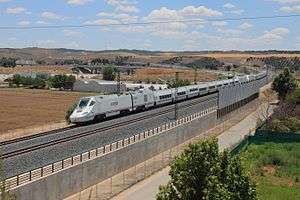RENFE Class 730
| RENFE Class 730 Talgo 250 | |
|---|---|
|
| |
| Manufacturer | Talgo[1] / Bombardier (Kassel)[2] |
| Number built | 15 |
| Capacity |
11 coach set: 299 seats, 236 standard, 62 first, 1 special[1] |
| Operator(s) | RENFE |
| Specifications | |
| Train length | 183 m (600 ft 4.7 in)[1] |
| Car length |
20 m (65 ft 7.4 in) (power car)[1] 13.14 m (43 ft 1.3 in) (passenger car)[3] |
| Width | 2.96 m (9 ft 8.54 in) (power car)[1] |
| Height | 4 m (13 ft 1.48 in) (power car)[1] |
| Maximum speed | 180 km/h (110 mph) |
| Weight | (?) |
| Axle load | max. axle load 18 t (17.7 long tons; 19.8 short tons)[1] |
| Traction system | Diesel-Electric |
| Prime mover(s) | 2x MTU 12V 4000 R43L (S730) |
| Power output |
2,400 kW (3,200 hp) @ 25 kV AC 2,000 kW (2,700 hp) @ 3 kV DC (per power unit)[1] 1.8 MW (2,400 hp) per power car in diesel mode (S730) |
| Electric system(s) | 25 kV 50 Hz AC / 3 kV DC[1]Catenary |
| Current collection method |
Pantograph (2 per power car) high voltage roof mounted electrical bus between power cars. |
| UIC classification |
Bo'Bo' 1,1,1,1,1,1,1,1,1,1,1,1 Bo'Bo' (11 car set) |
| Bogies |
BoBo (power car)[1] Articulated independent wheel 'single axle' in passenger cars[1] |
| Braking system(s) |
2 disc brakes per axle regenerative and rheostatic brakes in power cars[1] pneumatic discs in passenger cars[1] |
| Track gauge | 1,435 mm (4 ft 8 1⁄2 in) / 1,668 mm (5 ft 5 21⁄32 in)[1] |
The RENFE Class 730 or S-730[4] (Spanish: Serie 730 de Renfe, manufacturer's designation Talgo 250) is a high-speed dual-gauge, dual-voltage trainset consisting of 11 Talgo VII tilting coaches and two power cars, used on Alvia services.[5][6] The class have been nicknamed patitos (ducklings), due to the shape of the train nose.[7] They are an upgraded version of RENFE Class 130, in order to extend high-quality services to parts of Spain not on the high-speed network, so these hybrid trains can run with both electric and diesel power.
Background and design
The trainsets are designed for high-speed services on Iberian gauge (1,668 mm (5 ft 5 21⁄32 in)) and high-speed (1,435 mm (4 ft 8 1⁄2 in)) lines; they can change gauge at low speed without stopping using Talgo's RD variable gauge system.[8] The carriages are constructed from aluminium and incorporate the Talgo Pendular passive pendulum tilting system,[9] are sealed against pressure differences for tunnel travel,[1] and have underframe air conditioning, individual audio systems and video displays, rotating and reclining seats and power outlets.[3]
Capacity in standard class is 36 seated, in first class 26 seats, end coaches have lower capacity, one coach is typically used for restaurant/sales services.[1]
The locomotives use AC traction motors controlled by IGBT inverters which include integrated auxiliary inverters. Signalling systems can include ETCS Level 2, LZB, ASFA and Ebicab900TBS.[10]
Accidents and Incidents
2013 Santiago de Compostela accident
On 24 July 2013 a RENFE class S730[11] running as the Alvia 4155 service from Madrid to Ferrol derailed and crashed near Santiago de Compostela in north-western Spain, killing 78, out of 218 passengers on board. The cause of the accident is not yet officially determined, but the train was alleged to be traveling over twice the posted speed limit while entering a curve, due to the absence of ERTMS.[12]
See also
References
- 1 2 3 4 5 6 7 8 9 10 11 12 13 14 15 16 Talgo 250 www.talgo.de
- ↑ Bombardier Transportation in Germany Page 14, www.bombardier.com
- 1 2 High speed trainsets - subsection Passenger Car Features Talgo Series VII Passenger Coaches www.talgoamerica.com
- ↑ From Serie 730 de Renfe
- ↑ Trayectos y Servicios - clase preferente www.renfe.es
- ↑ Trayectos y Servicios - clase turista www.renfe.es
- ↑ "Los nuevos Alvia no convencen", www.lavozdeasturias.es (in Spanish), 11 February 2011
- ↑ “Talgo RD” Variable Gauge System: A solution to eliminate barriers in the transport of goods and passengers between East and West Rail Tech Russis, inter-nation conference, June 2007, conference.europoint.eu
- ↑ The Talgo Pendular Coaches www.talgoamerica.com
- ↑ The Talgo Pendular Coaches POWER HEAD TALGO 250, Page 7, www.talgoamerica.com
- ↑ http://media.skynews.com/media/images/generated/2013/7/24/250065/default/v1/train-crash-2-1-402x293.png
- ↑ Rodrigo Silva; Antonio Alonso (25 July 2013). "Accidente ferroviario en Santiago de Compostela". El País (in Spanish). Madrid. Retrieved 25 July 2013.
Other sources
- Talgo 250 information sheet www.talgo.es
- Information on the crash absorption and coupling module of the S130 powerheads www.esytech.de
External links
| Wikimedia Commons has media related to RENFE Class 730. |
- Renfe Serie 130 Information from www.ferropedia.es

